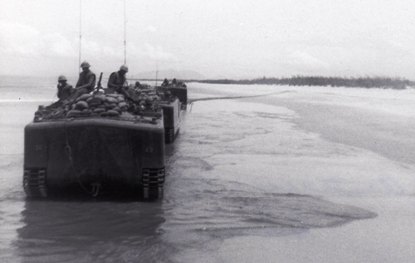| Ken and Bill's Excellent Adventure |
| XV. Vibrant Vietnam |
| Rice farming remains the primary economic activity of many Vietnamese, and on the drive to and from the DMZ, we could see farmers busily preparing their fields for the second of three annual crops the climate of the region allows. While we saw water buffalo grazing here and there, those lumbering beasts that inhabit the memories of almost any American who ever served in Vietnam during the war, we saw only one being used to plow a field. Most farmers now have motorized—if primitive—tractors, some that allow the driver to sit, others that the driver walks behind like a powered lawn mower. The planting itself, however, still seems to be done by hand, the very paradigm of backbreaking labor. (In Japan, machines are used to plant the rice, and one wonders how long it will be before that technology reaches Vietnam.) |
 A farmer plowing his field with a motorized tractor. Some were riding tractors, but this one was not. It powered itself, but the farmer had to walk behind it rather than riding on it. (AGE) |
 The only farmer we saw who was still using a water buffalo to plow his The only farmer we saw who was still using a water buffalo to plow hisrice field. (SA) |
| Everywhere you go, there is building, building, building. The construction industry is booming. In the cities. In the country. In the ever-expanding suburbs. Roads. Bridges. Houses. High-rise offices. Hotels. The ramshackle tin-and-cardboard hovels so many Vietnamese cobbled together during the war are gone. Even the thatched-roof rural houses are mostly gone, replaced by brick homes with ceramic tile roofs. A new hospital is going up north of Hue. An industrial park is going in south of Dong Ha. |
| And the beaches all up and down the coast of Vietnam are sprouting resorts like mushrooms after a hard rain. Where there isn’t a resort, one is under construction, or soon to be built according to the billboard posted on the site. In Hoi An, we stayed in the Hoi An Beach Resort, just across Phuoc Trac Bridge, where in 1967 there had been a small fishing village and a mangrove forest, the scene of some sharp engagements with the local Viet Cong. In Nha Trang, we stayed at the Sunrise Beach Hotel & Spa. If you hurry, you can buy a condominium along one of the fairways of the Greg Norman Golf Course at China Beach, Da Nang. Right: A beach-toy shop on the South China Sea near Hoi An. The barrier island is lined with grand resort hotels and tourist shops like this one. (SA) |
||
 Marine amphibious tractors (Amtracs) running the beach along the South China Sea east of Hoi An at the start of Operation Pike, 1967. (WDE) |
 The same beach where the Amtrac photo was taken, but 44 years later. (SA) |
(Background photo by AGE) |
Continue to next section |
Copyright © 2011 - W. D. Ehrhart - homepage